'Can we be counted too?' Recognising LGBTQ+ lives in the 1991 census
Until 2021, the census did not ask for information about sexuality or gender identity. Without this information it was difficult for the government to support the needs of a significant part of the population. One letter in our collection gives a personal perspective on why this data was needed.
A letter to John Major
The 1991 UK census, like all censuses, aimed to capture the whole population on one night, Sunday 21 April 1991. It was marketed with the tagline ‘It counts because you count.’ An abstract logo was used as part of the campaign, depicting a household and its inhabitants.
But not everyone felt represented.
As members of the population, LGBTQ+ people have always been recorded in the census, but not in a way that acknowledged their sexuality, same-sex partnerships, gender variations, non-conformity or transitions.
Six months after census night, one individual penned a passionate defence of capturing information about lesbian and gay lives. In a letter to Prime Minister John Major voicing their frustrations, they asked: ‘can we be counted too?’.

Transcript
Can we be counted too?
Dear Mr Major,
I read in the Daily Express that you are looking into the issue of Lesbian and Gay rights. Do you not think that your work in this area would be greatly improved if you had reliable statistics on the Lesbian and Gay population? Then your policies could be soundly based on statistical facts instead of on speculation and supposition?
Are you aware that the Lesbian and Gay population have been counted on the 1991 Census form in such a way that they appear heterosexual? Many Lesbian and Gay people tried to be counted on the 1991 Census as ‘Lesbians’ and Gays’. They were told that they had the right to put ‘Lesbian’ and ‘Gay’ on the form but would not be counted as such.
Lesbian and Gay people who have ticked “Living together as a couple” on the Census form will not be counted as a same-sex couple but will have their status changed to “unrelated”.
Can we be counted too?
Dear Mr Major,
I read in the Daily Express that you are looking into the issue of Lesbian and Gay rights. Do you not think that your work in this area would be greatly improved if you had reliable statistics on the Lesbian and Gay population? Then your policies could be soundly based on statistical facts instead of on speculation and supposition?
Are you aware that the Lesbian and Gay population have been counted on the 1991 Census form in such a way that they appear heterosexual? Many Lesbian and Gay people tried to be counted on the 1991 Census as ‘Lesbians’ and Gays’. They were told that they had the right to put ‘Lesbian’ and ‘Gay’ on the form but would not be counted as such.
Lesbian and Gay people who have ticked “Living together as a couple” on the Census form will not be counted as a same-sex couple but will have their status changed to “unrelated”.
First page of the letter by Gillian arguing for lesbian and gay representation in the census. Catalogue reference: RG 19/1144.
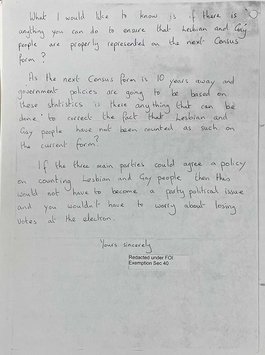
Translation
What I would like to know is if there is anything you can do to ensure that Lesbian and Gay people are properly represented on the next Census form?
As the next Census form is 10 years away and government policies are going to be based on these statistics is there anything that can be done to correct the fact that Lesbian and Gay people have not been counted as such on the current form?
If the three main parties could agree a policy on counting Lesbian and Gay people then this would not have to become a party political issue and you wouldn’t have to worry about losing votes at the next election.
Yours sincerely
[Redacted]
What I would like to know is if there is anything you can do to ensure that Lesbian and Gay people are properly represented on the next Census form?
As the next Census form is 10 years away and government policies are going to be based on these statistics is there anything that can be done to correct the fact that Lesbian and Gay people have not been counted as such on the current form?
If the three main parties could agree a policy on counting Lesbian and Gay people then this would not have to become a party political issue and you wouldn’t have to worry about losing votes at the next election.
Yours sincerely
[Redacted]
Page two of the letter.
The writer's name and address have been redacted from the record to protect their identity while they may still be living. They will be referred to by the randomly chosen pseudonym ‘Gillian’ throughout this article.
The importance of being counted
Gillian urged the government to actively use the census to capture data about LGBTQ+ people.
In the build up to the 1991 census, a briefing to the Prime Minister’s office described the ‘public sector need’ for ‘information to form and evaluate policy, to distribute resources effectively …, to plan and target services in a way that meets the most pressing needs of local populations’. In her handwritten letter, Gillian argued existing LGBTQ+ policy was based on ‘speculation and supposition’:
I read in the Daily Express that you are looking into the issue of Lesbian and Gay rights. Do you not think that your work in this area would be greatly improved if you had reliable statistics on the Lesbian and Gay population? Then your policies could be soundly based on statistical facts instead of on speculation and supposition?
Gillian demanded to know what the government was going to do to record this information in the next census, and what it might do to make up for the data it had missed. She believed the right statistics would help inform health, housing and employment policies for LGBTQ+ people. Socially and politically, 1991 was a challenging time for queer communities in Britain. Yet the impact on a significant part of the population was hard to determine without data to show the scale of the effect.
The early 1990s saw campaigns from various LGBTQ+ groups, including direct action group Outrage! who wanted LGBTQ+ representation in the census questions. The 1991 census was the first in the UK to include an ethnicity question. This caused controversy in its own right and also made clear the comparative absence of questions around sexuality and gender identity.
There was a practical policy need for this information, but also a desire for government recognition of queer lives, which had so long been disregarded, and at times, actively suppressed by the state. People like Gillian were demanding acknowledgement, visibility and affirmation.
Ten questions
Gillian set out ten questions for the government, ranging from ‘What percentage of the population are lesbian and gay?’ to ‘How many people are in the armed forces or teaching professions and are not able to express their sexuality openly?’

Transcript
Do you know :-
1) What percentage of the population are Lesbian and Gay?
2) How many people who have been obliged to identify themselves as ‘single/married/divorced or widowed’ are in fact Lesbian and Gay people possibly in long-term relationships with members of their own sex? (We are not legally allowed to be married to our same-sex partners)
3) How many people actually identified themselves as a same-sex couple on the Census form by ticking ‘living together as a couple’.
4) How many Lesbian and Gay people are already employed in the armed forces, teaching professions etc but are obliged to pass themselves off as heterosexuals for fear of losing their jobs.
5) How many mothers are in fact Lesbians?
6) What percentage of Lesbians do in fact become mothers? [these last two categories are on the whole “invisible” as Lesbian mothers tend to hide their identities for fear of losing custody of their children and in order to protect their children generally]
7) What percentage of Lesbian mothers are dependent on the state and what percentage are self-supporting or partly supported by their same-sex partner?
Do you know :-
1) What percentage of the population are Lesbian and Gay?
2) How many people who have been obliged to identify themselves as ‘single/married/divorced or widowed’ are in fact Lesbian and Gay people possibly in long-term relationships with members of their own sex? (We are not legally allowed to be married to our same-sex partners)
3) How many people actually identified themselves as a same-sex couple on the Census form by ticking ‘living together as a couple’.
4) How many Lesbian and Gay people are already employed in the armed forces, teaching professions etc but are obliged to pass themselves off as heterosexuals for fear of losing their jobs.
5) How many mothers are in fact Lesbians?
6) What percentage of Lesbians do in fact become mothers? [these last two categories are on the whole “invisible” as Lesbian mothers tend to hide their identities for fear of losing custody of their children and in order to protect their children generally]
7) What percentage of Lesbian mothers are dependent on the state and what percentage are self-supporting or partly supported by their same-sex partner?
The third page of the letter by Gillian, listing her questions for the prime minister.
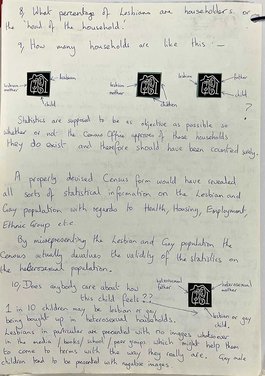
Transcript
8) What percentage of Lesbians are householders or the ‘head of the household’.
9) How many households are like this:-
Lesbian mother, lesbian, child. Lesbian mother, children. Lesbian, father, child.?
Statistics are supposed to be as objective as possible so whether or not the Census Office approves of these households they do exist and therefore should have been counted surely.
A properly devised Census form would have revealed all sorts of statistical information on the Lesbian and Gay population with regards to Health, Housing, Employment, Ethnic Group etc.
By misrepresenting the Lesbian and Gay population the Census actually devalues the validity of the statistics on the heterosexual population.
10) Does anybody care about how this child feels??
Heterosexual father, heterosexual mother, lesbian or gay child.
1 in 10 children may be lesbian or gay being brought up in heterosexual households. Lesbians in particular are presented with no images whatsoever in the media/books/school/peer groups which might help them to come to terms with the way they really are. Gay male children tend to be presented with negative images.
8) What percentage of Lesbians are householders or the ‘head of the household’.
9) How many households are like this:-
Lesbian mother, lesbian, child. Lesbian mother, children. Lesbian, father, child.?
Statistics are supposed to be as objective as possible so whether or not the Census Office approves of these households they do exist and therefore should have been counted surely.
A properly devised Census form would have revealed all sorts of statistical information on the Lesbian and Gay population with regards to Health, Housing, Employment, Ethnic Group etc.
By misrepresenting the Lesbian and Gay population the Census actually devalues the validity of the statistics on the heterosexual population.
10) Does anybody care about how this child feels??
Heterosexual father, heterosexual mother, lesbian or gay child.
1 in 10 children may be lesbian or gay being brought up in heterosexual households. Lesbians in particular are presented with no images whatsoever in the media/books/school/peer groups which might help them to come to terms with the way they really are. Gay male children tend to be presented with negative images.
Page four of the letter.
At this time Section 28 was in place, preventing local authorities, including schools, from ‘promoting’ homosexuality – affecting both students and teachers. Lesbian gay, bisexual and transgender people were not allowed to serve openly in the military, and the Armed Forces were exempt from 1967’s partial decriminalisation of homosexual acts between men.
Gillian was particularly concerned about lesbian mothers who may have felt the need to hide their identity on the census through fear of losing custody of their children. This was a key issue as they were regularly deemed ‘unfit’ parents through the courts at the time because of their sexuality. Initiatives such as the Lesbian Custody Group (established in 1982) helped women fight this through the family courts.
A briefing to John Major in 1991 shows the ‘homosexual issues’ the government felt were a priority to campaigners. It acknowledges many concerns that were important at the time, specifically in relation to the law, but does not cover many of the subjects raised as a priority for Gillian in her letter.
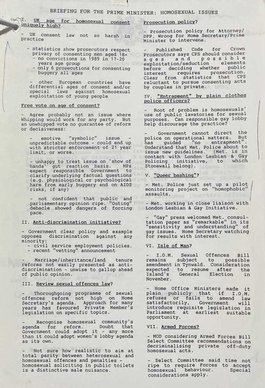
Partial transcript
Briefing for the Prime Minister: Homosexual issues
I. UK age for homosexual consent uniquely high?
[…]
Free vote on age of consent?
[…]
II. Anti-discrimination initiative?
[…]
III. Review sexual offences law?
[…]
Prosecution policy?
[…]
IV “Entrapment” by plain clothes police officers?
[…]
V. “Queer bashing”?
[…]
VI. Isle of Man?
[…]
VIII. Armed Forces?
Briefing for the Prime Minister: Homosexual issues
I. UK age for homosexual consent uniquely high?
[…]
Free vote on age of consent?
[…]
II. Anti-discrimination initiative?
[…]
III. Review sexual offences law?
[…]
Prosecution policy?
[…]
IV “Entrapment” by plain clothes police officers?
[…]
V. “Queer bashing”?
[…]
VI. Isle of Man?
[…]
VIII. Armed Forces?
Briefing for Prime Minister John Major before meeting actor and activist Ian McKellen, which shows the key ‘homosexual issues’ that government were aware of in 1991. Catalogue reference: PREM 19/4734.
'Does anyone care about how this child feels?'
Alongside these questions, Gillian annotated the census logo, demonstrating a variety of family units, including lesbian parents and children, that would not be fully captured through the details requested on the 1991 census.

Gillian's annotated 1991 census logos illustrating different family units reflecting LGBTQ+ lives.
One particular illustration depicts two heterosexual parents, and a lesbian or gay child. Gillian writes, ‘Does anyone care about how this child feels?’
She notes that one in ten children may be lesbian or gay and being brought up in heterosexual households. Due to Section 28, there no was formal education about sexuality or gender identity for a child growing up at this time and going through the school system.
Gillian also noted lesbian representation in the mainstream media was non-existent, whereas for gay male children it tended to be negative images.
Increased pressure
A letter that sits alongside Gillian’s communication is from Immunity Legal Centre, which fought for the legal rights of those affected by HIV and AIDS. They saw the desperate need for statistics, to determine the success of previous safe sex campaigns and to get larger samples of statistical data on gay lives.
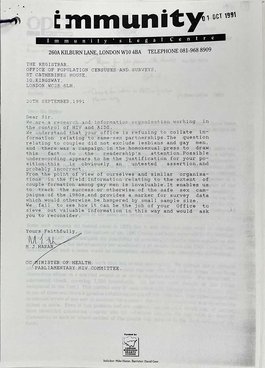
Transcript
The Registrar,
Office of Population Census and Surveys,
St Catherines House,
10, Kingsway,
London WC2B 6LH
20th September, 1991
Dear Sir,
We are a research and information organisation working in the control of HIV and AIDS.
We understand that your office is refusing to collate information relating to same-sex partnerships. The question relating to couples did not exclude lesbians and gay men, and there was a campaign in the homosexual press to draw this fact to the readership’s attention. Possible underecording appears to be the justification for your position: this is obviously an untested assertion, and probably incorrect.
From the point of view of ourselves and similar organisations in the field, information relating to the extent of couple formation among gay men is invaluable. It enables us to track the success or otherwise of the safe sex campaigns of the 1980s, and provides a marker for survey data which would otherwise be hampered by small sample size.
We fail to see how it can be the job of your Office to sieve out valuable information in this way and would ask you to reconsider.
Yours faithfully
M J Haran
CC Minister of Health
Parliamentary HIV Committee
The Registrar,
Office of Population Census and Surveys,
St Catherines House,
10, Kingsway,
London WC2B 6LH
20th September, 1991
Dear Sir,
We are a research and information organisation working in the control of HIV and AIDS.
We understand that your office is refusing to collate information relating to same-sex partnerships. The question relating to couples did not exclude lesbians and gay men, and there was a campaign in the homosexual press to draw this fact to the readership’s attention. Possible underecording appears to be the justification for your position: this is obviously an untested assertion, and probably incorrect.
From the point of view of ourselves and similar organisations in the field, information relating to the extent of couple formation among gay men is invaluable. It enables us to track the success or otherwise of the safe sex campaigns of the 1980s, and provides a marker for survey data which would otherwise be hampered by small sample size.
We fail to see how it can be the job of your Office to sieve out valuable information in this way and would ask you to reconsider.
Yours faithfully
M J Haran
CC Minister of Health
Parliamentary HIV Committee
Letter by Immunity Legal Centre asking for sexuality to be recorded through the census. Catalogue reference: RG 19/1144.
They repeatedly wrote into various government departments to lobby for a change in approach to the census. Immunity Legal Centre described this information as ‘invaluable’ as other data gathering attempts had too small a sample size. The Office of Population Censuses and Surveys (OPCS) emphasised their concern over inaccurate data but Immunity saw this as an ‘untested assertion, and probably incorrect’, asking instead to have access to the raw data.
‘Living together as a couple’
On the 1991 census, ‘living together as a couple’ had been added as a new option on the ‘Relationship in household’ question to try and capture the increase in unmarried partners.
Activist organisations and the gay press encouraged lesbian and gay people to tick the ‘Living together as a couple’ option. However, if a same-sex couple selected this, they would be categorised as ‘unrelated’ people living together. Children living with same-sex parents would be listed as children of ‘lone parents’, essentially erasing their parents’ relationship. There was also no opportunity to record your sexuality as a single person or as someone who did not live with their partner.
A last-minute attempt had been made with sample census results to use the ‘living together as a couple’ response to record LGBTQ+ people, but test data showed the information was wildly inaccurate. The test results ironically did a disservice to the very communities they would have been trying to recognise.
Fundamentally the ‘Relationship in household’ question was not designed to capture this information, and the ambiguous wording did not encourage disclosure of sexuality. An official noted, ‘if we want the data we must ask the question’.
A reply to Gillian’s concerns from the Office of Population Censuses and Surveys (OPCS) said that collecting such statistics was ‘seriously considered’. They denied it was ‘a deliberate policy not to count gay people’. LGBTQ+ groups however saw this as an intentional misreading and erasure of queer lives.
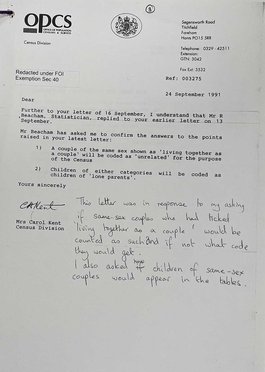
Transcript
24 September 1991
Dear [redacted]
Further to your letter of 16 September, I understand that Mr R Beacham, Statistician, replied to your earlier letter on 13 September.
Mr Beacham has asked me to confirm the answers to the points raised in your last letter:
1) A couple of the same sex shown as ‘living together as a couple’ will be coded as ‘unrelated’ for the purpose of the Census
2) Children of either categories will be coded as children of ‘lone parents’.
Yours sincerely
Mrs Carol Kent
Census Division
[Handwritten addition]
This letter was in response to my asking if same-sex couples who had ticked ‘living together as a couple’ would be counted as such and if not what code they would get.
I also asked how children of same-sex couples would appear in the tables.
24 September 1991
Dear [redacted]
Further to your letter of 16 September, I understand that Mr R Beacham, Statistician, replied to your earlier letter on 13 September.
Mr Beacham has asked me to confirm the answers to the points raised in your last letter:
1) A couple of the same sex shown as ‘living together as a couple’ will be coded as ‘unrelated’ for the purpose of the Census
2) Children of either categories will be coded as children of ‘lone parents’.
Yours sincerely
Mrs Carol Kent
Census Division
[Handwritten addition]
This letter was in response to my asking if same-sex couples who had ticked ‘living together as a couple’ would be counted as such and if not what code they would get.
I also asked how children of same-sex couples would appear in the tables.
Reply to Gillian from OPCS, including her annotated comments. Catalogue reference: RG 19/1144.
Gillian urged the government not to turn this into an election issue that might cause division and prevent progress on this issue:
If the three main parties could agree a policy on counting Lesbian and Gay people then this would not have to become a party political issue and you wouldn’t have to worry about losing votes at the next election.
To be counted or not?
In 2021, England, Wales and Northern Ireland were the first countries in the world to hold a national census that asked about sexual orientation – decades after Gillian’s ardent demands. A question about gender identity was also asked. In a significant shift from the 1991 census, LGBTQ+ organisations were actively consulted about the 2021 census questions.
The 2021 census recorded 3.2% of the population as identifying as gay, lesbian, bisexual, or another sexual orientation. But concerns about under reporting continue.
Gillian’s letter highlights the complexity of asking these questions at a time when people’s professions may have made it difficult or even illegal to openly identify as gay or lesbian. For some parts of the LGBTQ+ community there was, and is, a natural scepticism in being asked for this information. The historical persecution of LGBTQ+ lives by the state, as well as concerns about privacy and even immigration status make many people reluctant to disclose their sexuality and gender identity in the census.
But some LGBTQ+ people, such as Gillian, were explicitly asking to be recognised. They demanded to be heard and that the government should recognise them and act in their interests.
Records featured in this article
-
- Title
- Prime Minister's Office records on Home Affairs and the Census
- Date
- 1991
